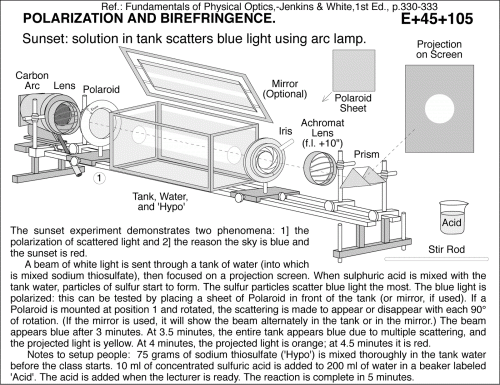Sunset: solution in tank scatters blue light, using arc lamp.
Primary tabs
Sunset: solution in tank scatters blue light using arc lamp. Ref.: Fundamentals of Physical Optics,-Jenkins & White,1st Ed., p.330-333 The sunset experiment demonstrates two phenomena: 1] the polarization of scattered light and 2] the reason the sky is blue and the sunset is red. A beam of white light is sent through a tank of water (into which is mixed sodium thiosulfate), then focused on a projection screen. When sulphuric acid is mixed with the tank water, particles of sulfur start to form. The sulfur particles scatter blue light the most. The blue light is polarized: this can be tested by placing a sheet of Polaroid in front of the tank (or mirror, if used). If a Polaroid is mounted at position 1 and rotated, the scattering is made to appear or disappear with each 90 deg of rotation. (If the mirror is used, it will show the beam alternately in the tank or in the mirror.) The beam appears blue after 3 minutes. At 3.5 minutes, the entire tank appears blue due to multiple scattering, and the projected light is yellow. At 4 minutes, the projected light is orange; at 4.5 minutes it is red. Notes to setup people: 75 grams of sodium thiosulfate ('Hypo') is mixed thoroughly in the tank water before the class starts. 10 ml of concentrated sulfuric acid is added to 200 ml of water in a beaker labeled 'Acid'. The acid is added when the lecturer is ready. The reaction is complete in 5 minutes. This is known as the Tyndall effect.
UCB Index:
E+45+105
PIRA Index:
6H50.10
UCB Taxonomy:
Video:
Popularity:
- Log in to post comments

